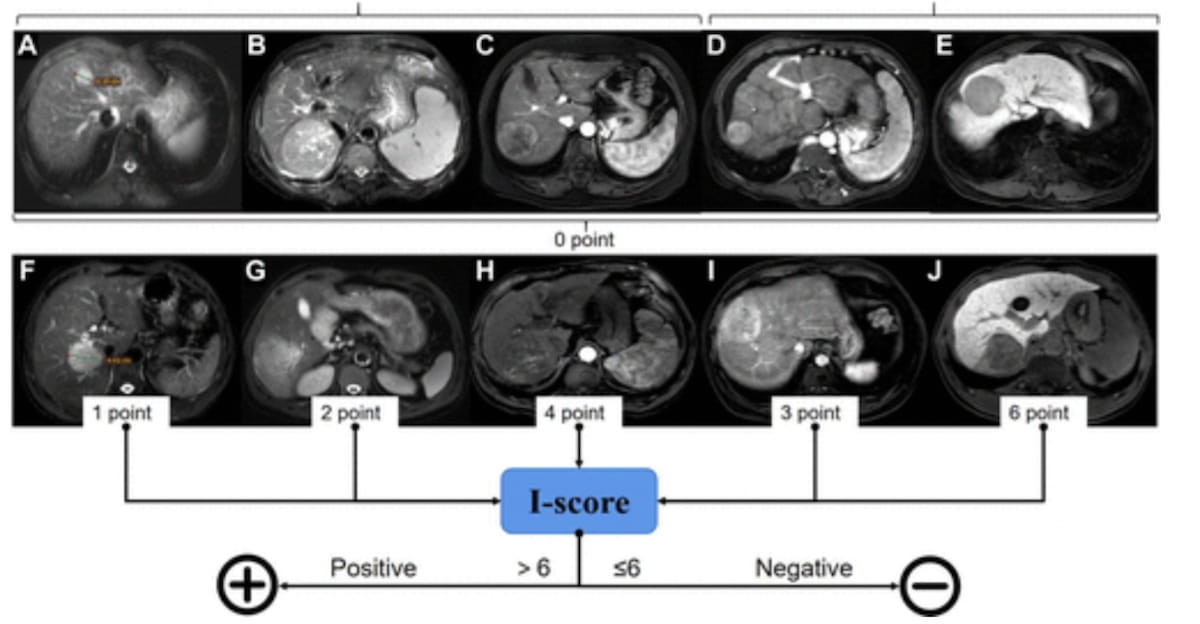New research suggests an emerging scoring system for gadoxetic acid-enhanced magnetic resonance imaging (MRI) may help predict the development of microvascular invasion (MVI) and other pathologic features linked to early recurrence and metastasis with hepatocellular carcinoma (HCC).
For the retrospective multicenter study, recently published in Radiology, researchers reviewed data from preoperative MRI scans (obtained with the gadoxetic acid contrast agent) for 366 patients (median age of 57) with hepatocellular carcinoma. The study authors developed an MRI scoring model, called the Image score (I-score), which includes assessment for maximum tumor diameter (TD-max), peritumoral enhancement, intratumoral arteries (ITAs), irregular morphology and peritumoral signal intensity.
In two external validation cohorts, the MRI scoring model offered an average 85 percent area under the curve (AUC) for predicting pathologic features. While the model had an average sensitivity rate of 80.5 percent, the study authors noted average specificity of 89 percent and average positive predictive value (PPV) of 90.5 percent.
“A comprehensive evaluation of pathologic features in hepatocellular carcinoma (HCC) via a scoring model based on gadoxetic acid–enhanced MRI features may be helpful for the prognostic evaluation of patients with HCC,” wrote lead study author Kun Zhang, M.D., who is associated with the Department of Radiology at the Medical Imaging Institute of Tianjin at Nankai University in Tianjin, China, and colleagues.
Multivariable analysis revealed that no utilization of postoperative adjuvant transarterial chemoembolization (PA-TACE) was associated with a 4.6 times higher risk for early HCC recurrence. The researchers also found that MVI and positive findings with the I-score model were independently associated with a greater than fivefold higher risk for early recurrence.
Three Key Takeaways
1. I-Score as a prognostic tool. The MRI-based I-score, which assesses features like tumor diameter, peritumoral enhancement, and intratumoral arteries, demonstrated high predictive accuracy (85 percent AUC) for predicting high-risk pathologic features in patients with hepatocellular carcinoma (HCC).
2. Impact of PA-TACE on recurrence risk. Patients who did not receive postoperative adjuvant transarterial chemoembolization (PA-TACE) had a 4.6 times higher risk of early HCC recurrence, highlighting the potential benefit of PA-TACE in reducing recurrence rates.
3. Enhanced prognostic performance with combined model. A combined model incorporating the I-score, MVI status, and PA-TACE absence showed superior prognostic performance (84 percent C index) compared to using MVI or PA-TACE alone, suggesting its potential clinical utility for early recurrence risk stratification.
In a separate outcome cohort involving 87 patients, the study authors noted that a prognostic model that combined the I-score with MVI and no PA-TACE offered an 84 percent C index for predicting early HCC recurrence in contrast to 72 percent for no PA-TACE alone and 71 percent for MVI alone.
“We found the I-score to be an independent predictor of early recurrence,” emphasized Zhang and colleagues. “ … The combined model including the I-score, no PA-TACE, and MVI demonstrated superior prognostic performance, suggesting its potential in prognostic evaluation.”
(Editor’s note: For related content, see “Abbreviated MRI for Hepatocellular Carcinoma: What a Meta-Analysis Reveals,” “Deep Learning Model with DCE-MRI May Help Predict Proliferative Hepatocellular Carcinoma” and “Comparative Study Says Enhanced MRI Offers Optimal Detection of Neuroendocrine Tumor Liver Metastases.”)
In regard to study limitations, the authors acknowledged a small sample size for validation testing, possible variation in MRI scan parameters at different facilities and limiting the cohort to patients who had gadoxetic acid-enhanced MRI scans.
